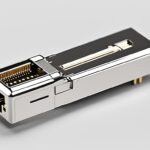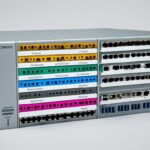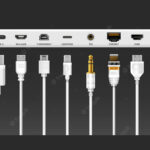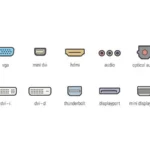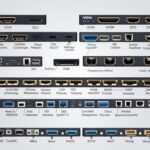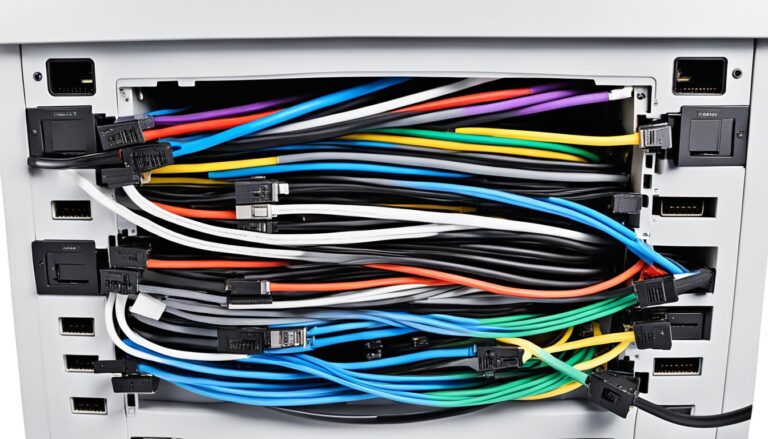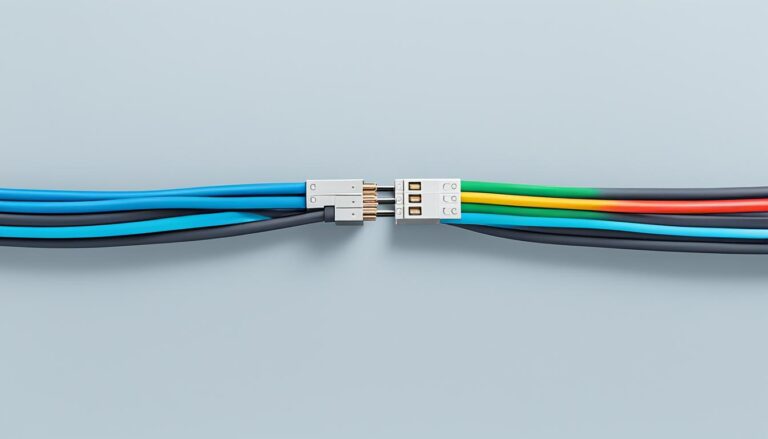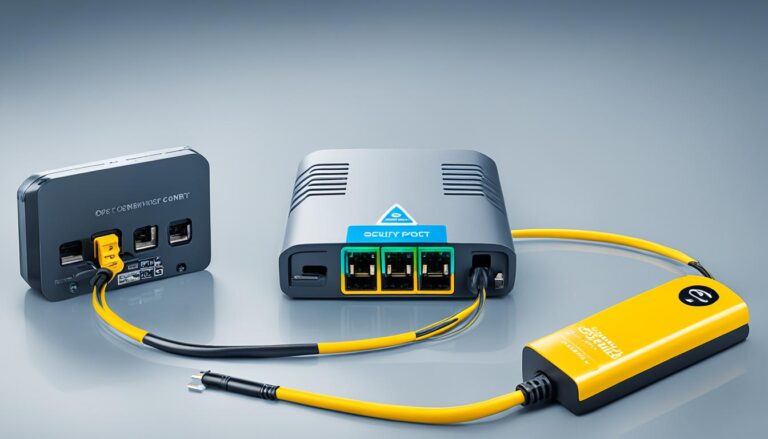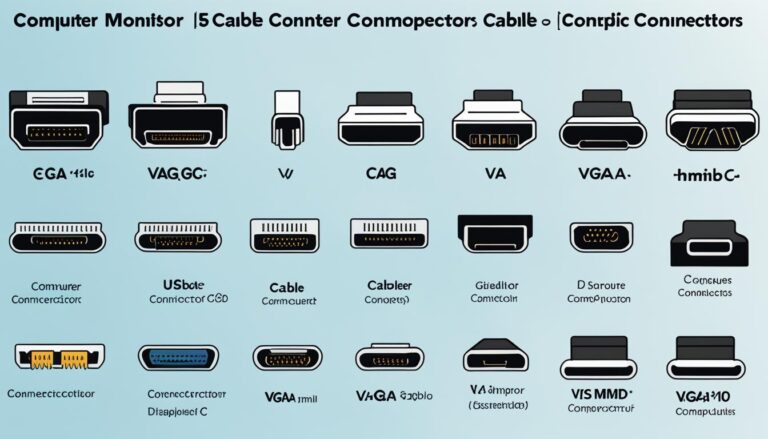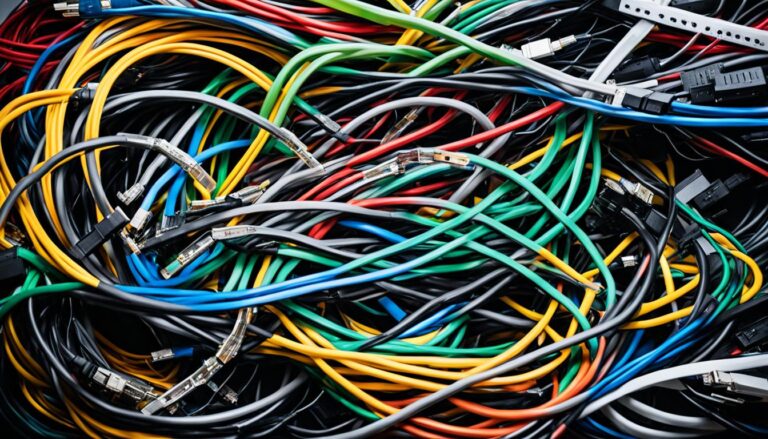Display ports are key for linking video devices to screens. There are many types, each with special features. This guide looks at these display ports, what they do, and which one you should use.
Finding the right display port is vital for video device connectivity. It matters for gamers, creatives, and everyday users. Knowing your options helps you get the best video quality and device compatibility.
We’ll examine different display port types and what they’re used for. You’ll learn about VGA, DVI, HDMI, DisplayPort, and more modern options like USB-C and Thunderbolt. This section aims to show the benefits of each, especially for video and audio.
After reading this guide, you’ll understand the various display ports, their features, and how to pick the right one. This knowledge is crucial whether you’re setting up a gaming rig, a home cinema, or professional AV equipment. It will guide your decisions.
Overview of Display Port Types
Today, we have many display port types for video connectivity. Each one offers unique features for different needs. Let’s explore the different display port types and what they do:
HDMI (High-Definition Multimedia Interface)
HDMI is top choice for sound and picture signals. It’s perfect for home cinemas and multimedia systems. HDMI cables handle both sound and picture, so you don’t need more cables. Enjoy great visuals and sound with HDMI.
DVI (Digital Visual Interface)
DVI is great for video only. It delivers high-quality digital video, good for monitors and projectors. With DVI cables, expect clear and crisp visuals on your screen.
DisplayPort
DisplayPort stands out for audio and video quality. It’s great for gaming, design, and video editing. DisplayPort cables give top image quality and easy device connection.
VGA (Video Graphics Array)
VGA is an older connection type, supporting lower resolutions. It’s less common now but still used in some older systems.
USB-C (Universal Serial Bus Type-C)
USB-C is versatile and becoming more popular. It can carry display, power, and data, all in one. Find USB-C in many modern devices like laptops and phones.
Thunderbolt
Thunderbolt is ultra-fast for data and video. It’s great for professional settings needing high-performance connections. Thunderbolt manages several high-res displays effortlessly.
AV (Audio-Visual)
AV is for analog sound and picture, often in older equipment. While not as sharp as digital, AV is still used in some setups.
NDI (Network Device Interface)
NDI sends sound and picture over a network. It’s ideal for live video production, merging many video sources easily.
SDI (Serial Digital Interface)
SDI is preferred in professional video production. It offers long-distance and reliable transmission. SDI is essential in broadcasting and cinema for its steadiness.
Each port type serves specific needs, from high-def audio and visuals to efficient data transfer. Whether it’s for advanced applications or reliable analog connections, there’s a suitable display port for you.
VGA and DVI: The Legacy Connectors
VGA (Video Graphics Array) and DVI (Digital Visual Interface) are known as legacy connectors. They were key in the development of display tech. Even if not widely used today, they are still important in some cases.
VGA – An Old-School Analog Connector
VGA became the standard for analog video signals. It was everywhere: in old video cards, CRT screens, and older devices. Now, digital standards and the push for better resolutions have reduced its use.
As an analog connector, VGA transmitted images through electrical signals. Despite its limits on quality and resolution, it was popular. It was essential for the display tech world for a long time.
DVI – The Digital Replacement
DVI came next, offering a digital option for video. It’s still found in many computers and LCD screens today.
DVI’s key feature was sending both analog and digital signals. This made moving from VGA easier. It also improved image quality and resolution support. This made DVI great for those wanting the best visuals.
DVI has different types: DVI-I, DVI-D, and DVI-A. Each has its own use. Despite new tech, DVI is valued for its quality and compatibility.
In Summary
Although seen as old, VGA and DVI connectors are still useful. VGA was crucial in the early display tech days. DVI took over with better quality and digital signals. They both have shaped how we connect to video today.
HDMI: The King of Multimedia
HDMI (High-Definition Multimedia Interface) is widely used for connecting audio and video. It lets you send high-definition video and audio through one cable. This means you don’t need lots of cables to connect your devices. HDMI is used in modern TVs, Blu-ray players, game consoles, and more.
HDMI supports many resolutions. It works with different display devices. You can watch movies in clear 4K or enjoy 3D pictures. HDMI brings life-like visuals to your screen.
HDMI makes sure the audio in your multimedia is top-notch. This means you get surround sound that pulls you into the action. Pair this with sharp visuals for a complete experience.
Additionally, HDMI uses HDCP (High Bandwidth Digital Content Protection). This stops the illegal copying of videos and audio. It lets you enjoy movies and games without worrying about copyright.
HDMI is also easy to use. Its plug-and-play feature means connecting devices is effortless. No need for extra settings. This makes HDMI perfect for everyone.
“HDMI offers a seamless audio and video experience with support for high resolutions and a single cable connection.”
To conclude, HDMI is perfect for multimedia. It sends high-quality audio and video over one cable. It supports various resolutions and 3D images. HDMI also cares about audio, protects your content, and is easy to use. That’s why it’s the best way to connect your devices and enjoy great multimedia.
| HDMI Features | Description |
|---|---|
| High-Definition Video | Supports high resolutions, including 4K, for sharp and vibrant visuals. |
| Audio Integration | Transmits audio signals alongside video for an immersive multimedia experience. |
| HDCP Protection | Prevents piracy and unauthorized copying of audio and video materials. |
| Plug-and-Play | Simple and user-friendly connection without additional configurations. |
With HDMI, enhance your audio and video quality easily. Relish seamless connectivity and remain secure with content protection. Discover what HDMI brings to your media setup. Experience multimedia like never before.
DisplayPort: The Versatile Choice
DisplayPort is a versatile connector for audio and video signals. It supports high resolutions and refresh rates, making it great for gaming and work.
It shines with its ability to handle high resolutions. This means better visual clarity whether you’re gaming or working on graphics.
Another perk is its long cabling. This gives you more room to set up your display, especially in big spaces.
Although DisplayPort was less known before, it’s now getting more popular. Many computers have it, and it’s becoming a cost-effective alternative to HDMI.
Benefits of DisplayPort:
- High Resolutions: DisplayPort supports high resolutions for sharp, detailed visuals.
- Seamless Audio and Video Transmission: You can enjoy synced audio and video without delays.
- Impressive Cabling Length: With long cables, it’s easy to arrange your display setup.
- Cost-Effective Alternative: It’s a more budget-friendly choice compared to HDMI.
Let’s compare DisplayPort to HDMI:
| Connector | Type of Signal | Maximum Resolution | Advantage |
|---|---|---|---|
| HDMI | Audio and Video | Up to 4K | Standard for multimedia devices |
| DisplayPort | Audio and Video | Up to 8K | Supports higher resolutions |
This shows DisplayPort is better for higher resolutions. It’s the top choice for top-quality visuals.
DisplayPort is great for connecting audio and video. It offers high resolutions, smooth transmission, and long cables. Its growing popularity and affordability make it a smart pick for enhancing multimedia.
DisplayPort lets you enjoy the best of your audio and video. It’s perfect for gamers and professionals in media. Try DisplayPort to boost your visual experience today.
USB-C and Thunderbolt: The Future of Connectivity
USB-C and Thunderbolt are changing how we connect devices. They can handle video, audio, data, and power. USB-C is famous for working with many devices. It fits no matter how you plug it in. This makes it ideal for phones, tablets, and computers.
Thunderbolt, made by Intel, moves videos very fast. It’s perfect for heavy tasks like video editing. With Thunderbolt, work flows better, making it easier to produce great visuals.
Enhanced Video and Audio Experience
USB-C and Thunderbolt offer great video and sound. They support high-quality pictures for a better watching experience. Whether watching films or doing a presentation, they make everything look and sound better.
They also improve music and calls. You’ll notice clearer sound, whether listening to music or in a meeting. It lifts your audio experience.
Powerful Data Transfer
USB-C and Thunderbolt are also great for moving data. USB-C does this quickly and easily. It’s simple to share large files or back up data. Thunderbolt moves data even faster, helping with big tasks quickly.
Unmatched Compatibility
USB-C works with many devices, like MacBooks and phones. It means you don’t need many different cables. It makes connecting devices easier and more flexible.
Thunderbolt is amazing but not all devices can use it yet. Make sure your device can before getting Thunderbolt items. But, more devices are starting to use it for its speed.
USB-C and Thunderbolt are shaping the future of how we connect. As technology grows, these connectors will do even more. They’ll help our devices work together better.
USB-C and Thunderbolt offer great convenience and efficiency. They’re perfect whether you need strong connections for work or want to reduce cable mess. They’re the best choices for connecting our future.
Conclusion
Choosing the right display port type is vital for the best video link. You should think about what your video devices need. Understand each port type’s abilities. HDMI and DisplayPort are great choices. They provide stable audio and video for many devices. These ports are perfect for both entertainment at home and work.
VGA and DVI connectors are still used, mainly in old systems. They might not be as good as HDMI and DisplayPort. Yet, they can still offer a dependable video link for some devices.
USB-C and Thunderbolt are great for those wanting many features and to be ready for the future. They handle video and audio, but also data and power. USB-C works well with many devices, like smartphones, laptops, and tablets. Thunderbolt is the best for fast video speeds and linking several high-quality displays.
Knowing about different display port types helps you choose wisely for your video devices. Consider what your devices need. Pick the display port that gives the best match and performance for your setup. Whether it’s HDMI, DisplayPort, VGA, DVI, USB-C, or Thunderbolt. Picking the right video link is key to improving your viewing and getting the most from your video devices.
FAQ
What is a display port?
A display port connects video devices to monitors or displays. It is a key connector for video transmission.
What are the different types of display ports?
There are many types of display ports. They include HDMI, DVI, DisplayPort, VGA, and USB-C among others. Each has different uses.
What is HDMI used for?
HDMI transmits audio and video. It’s found in TVs, Blu-ray players, and game consoles. It’s great for home entertainment.
What is DVI used for?
DVI is for video-only connections. You’ll find it in desktops and LCD monitors. It’s very useful for visual setups.
What is DisplayPort used for?
DisplayPort is for high-quality audio and video. It suits high-end gaming and professional uses. It offers excellent signal transmission.
What is VGA used for?
VGA is a legacy connector. It suits older video cards and CRT displays. It’s used with legacy devices mainly.
What is USB-C used for?
USB-C is a versatile connector. It works with smartphones, tablets, laptops, and PCs. It can replace multiple cables.
What is Thunderbolt used for?
Thunderbolt connects to external devices. It supports high-resolution screens. It’s great for expanding your display setups.
What is the difference between USB-C and Thunderbolt?
USB-C is common and easy to use. Thunderbolt is faster but less compatible. Each has unique benefits.
How do I select the right display port type?
To choose the right port, evaluate your device needs. Consider each port’s capabilities. This ensures the best connection.



